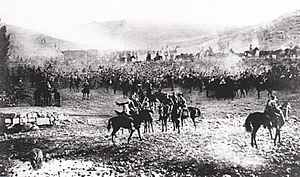Chaytor's Force facts for kids
Quick facts for kids Chaytor's Force |
|
|---|---|
| Active | 13 August – 31 October 1918 |
| Country | British Empire |
| Allegiance | British Crown |
| Type | Mounted Infantry Infantry Artillery |
| Size | Reinforced Division of 11,000 |
| Part of | Desert Mounted Corps Egyptian Expeditionary Force |
| Engagements | First World War |
| Commanders | |
| Notable commanders |
Edward Chaytor |
Chaytor's Force was a special group of soldiers during World War I. It was active from August 13 to October 31, 1918. This force was named after its leader, Major General Edward Chaytor.
It was part of the British Egyptian Expeditionary Force. This force fought in the Sinai and Palestine Campaign. Chaytor's Force had about 11,000 soldiers. It included different types of troops like mounted soldiers (on horses), infantry (foot soldiers), and artillery (big guns).
One main job of Chaytor's Force was to trick the Ottoman army. They wanted the Ottomans to think the main British force was in a different place. To do this, they set up fake camps and gun positions. They even used mules to drag branches, making dust to look like many soldiers were moving.
Soldiers would march into the Jordan Valley each day. Then, trucks would drive them out at night. This made it seem like more troops were arriving. Later, Chaytor's Force protected the right side of the British army. They faced the Turkish Fourth Army.
Key Operations
General Allenby gave Chaytor's Force clear orders. They had to be ready to attack at any time. Their goal was to stop the enemy from moving troops to other battle areas. They also had to protect the right side of the British XX Corps as it moved forward.
If the Turkish army became weaker in the Jordan Valley, Chaytor's Force was to advance. They were to capture the bridge at Jisr ed Damieh. From there, they would move east across the Jordan River. Their targets were Es Salt and Amman. They would also work with Arab forces.
From September 19 to 20, 1918, big battles happened elsewhere. These were the Battle of Sharon and the attack by XX Corps. During this time, Chaytor's Force held their position in the Jordan Valley. They kept the Turkish Fourth Army busy with active demonstrations.
On September 21, the Turkish Fourth Army began to retreat. Chaytor's Force cut off their escape route at Kh Fasail. This was the main path for the Turkish Eighth and Seventh Armies. The New Zealand Mounted Rifles Brigade then attacked Jisr ed Damieh. This was a key bridge over the Jordan River. Many retreating Ottoman soldiers were using this bridge.
On September 22, Chaytor's Force captured the headquarters of the Ottoman 53rd Division. They also cut off the retreat route along the Nablus road. The New Zealand Mounted Rifles Brigade and some British West Indies Regiment soldiers attacked the Jisr ed Damieh bridge. A group of Auckland mounted soldiers even charged across the bridge. They captured many prisoners.
Other crossing points over the Jordan River were also captured on September 22. These were Umm esh Shert and Mafid Jozele.
Chaytor's Force crossed the Jordan River on September 23. They advanced towards Es Salt. They captured it that evening after fighting the enemy's rear guards. The force then moved towards Amman. They attacked and captured Amman on September 25.
At Ziza on September 28, Chaytor's Force captured the Southern Force of the Turkish Fourth Army. By October 2, Chaytor's Force had captured Amman. They took over 10,000 prisoners of war. They also captured many artillery guns, machine guns, railway engines, and vehicles.
Who Was in Chaytor's Force?
Chaytor's Force was made up of different military units. Here are some of the main parts:
- Commander: Major-General Sir E. W. C. Chaytor.
- Staff: These were officers who helped plan and manage the force.
- ANZAC Mounted Division: This included soldiers from Australia and New Zealand. They had several Light Horse Brigades and the New Zealand Mounted Rifles Brigade. These were soldiers who fought on horseback.
- 20th Indian Brigade: This group included various infantry battalions. Some were from India, like the Mahratta Light Infantry and Patiala Infantry. There were also battalions from the Jewish Legion (Royal Fusiliers) and the British West Indies Regiment.
- Artillery Units: These units operated the big guns. They included batteries from the Royal Horse Artillery, Royal Field Artillery, and Indian Mountain Battery.
- Other Attached Units: There were also engineers, machine gun squads, and anti-aircraft sections. They even used some captured Ottoman guns.
The force also had a lot of transport. This included donkeys, tractors, and many trucks. These vehicles helped move supplies and ammunition.


